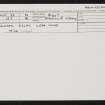Islay, Kilslevan
Copper Mine (Post Medieval), Lead Mine (Post Medieval)
Site Name Islay, Kilslevan
Classification Copper Mine (Post Medieval), Lead Mine (Post Medieval)
Alternative Name(s) Kilsleven; Lossit
Canmore ID 38120
Site Number NR46NW 25
NGR NR 4143 6709
Datum OSGB36 - NGR
Permalink http://canmore.org.uk/site/38120
- Council Argyll And Bute
- Parish Killarow And Kilmeny
- Former Region Strathclyde
- Former District Argyll And Bute
- Former County Argyll
NR46NW 25 41 67.
For general summary of Islay lead mining, see NR36NE 21.
Lead mining at Kilslevan succeeded the working of copper ore which had commenced there about 1760. [For a general account of lead mining on Islay, see NR36NE 21]
RCAHMS 1984a.
Field Visit (May 1976)
Traces of former lead-workings on Islay are distributed over a wide area which extends from Balulive in the N to Loch Bharradail in the S, and they are associated with groups of Dalradian limestone. The most extensive remains of lead mines on Islay are at Mulreesh (NR4068), where there are abandoned shafts, waste-dumps and an adit, together with the ruins of a rubble-built engine house and an ore-dressing plant, all belonging to the latest phases of mining activity in the second half of the 19th century. Much of the limestone was evidently ore-bearing at the surface and, according to Dr John Walker, this was the first recorded discovery of metallic veins in limestone in Scotland (en.1). Earlier mining operations are indicated by a surrounding field of open-cast workings, the ubiquitous ‘trenching ... not above six feet deep' observed by Pennant in 1772 and the 'innumerable shallow pits and trenches' criticised by another visitor to the mines some time before 1810 (en2).
The remains of similar open-cast operations and later shafts can be seen at the former mines of North and South Ardachy which cover much of the area E and SE of Loch Bharradail (NR3963), and which together formed one of the main centres of the island's lead-mining industry in the 18th century. Another principal vein that was worked in similar fashion is situated at Gartness (NR3965- 6) SE of Ballygrant village, while lead-mining at Kilslevan (NR4167) succeeded the working of copper ore which had commenced there about 1760. There are no identifiable remains of the lead smelting furnace that was in operation at the date of Pennant's visit in 1772 (en3); it was situated 'near Freeport', an unidentified site near Port Askaig, probably at, or close to the site of the later distillery at Caol Ila (NR428700).
Many of the old workings may be of medieval origin, and in 1549 Donald Monro referred to the occurrence of 'mekle leid ovir (much lead ore) in Moychaolis' (en.4). An abortive attempt was made to realise some of the value of the lead deposits in 1619, and from about 1680 onwards the workings were intermittently exploited by a succession of lessees, most notably during the third quarter of the 18th century and again after 1862 (en.5). Mining operations ceased in about 1880 and much of the plant and machinery was sold after the termination of the final lease in 1904.
Detailed reports compiled in 1770 gave a comparatively favourable account of the physical condition and potential capacity of the mines, the expense of working them and the quality of the lead itself which was said to have much impressed Alexander Sherriff, manager of the Leadhills mines (en.6). The reports provide some indication of the amount and value of the lead extracted, but the only available annual set of figures on output relate to the last active phase at Mulreesh (NR46NW 7) between 1862 and 1880; during that nineteen-year period a total of 1,919 tons of ore produced 1,426 tons of lead and 18,424 ounces of silver (en.7).
There are few reliable details concerning the size and composition of the work-force. It is known, however, that John Taylor, a celebrated centenarian (en.8), was employed as overseer of a large body of English miners on Islay during the earlier part of his career from 1708 to 1730, and a rental of 1722 records that the dwellings of the miners 'in the mynes of Isla' were at that date situated at Knocklearoch (en.9) where building-foundations of indeterminate date and character are still to be found in the vicinity of the more modern farmstead (NR399649).
RCAHMS 1984, visited May 1976
Endnotes
1.McKay, M M (ed.), The Rev Dr John Walker's Report on the Hebrides of 1764 and 1771 (1980), 106.
2.Pennant, Tour (1772) , 1, 250; Williams, J, The Natural History of the Mineral Kingdom (2nd ed., 1810), 1, 276.
3.Pennant, loc. cit. See also British Library, Add. MS 15,509, fol. 5.
4.Monro, Western Isles, 55. For 'Moychaolis', see Inventory of Argyll, 4, 274, n.200.
5.Islay Bk. , 365- 7, 456-7; Islay Estate Papers, Mining Papers (uncatalogued). See also Nat. Lib. of Scot., Murray of Stanhope Papers, Adv. MS 29.1. 1, vol. 7, fol. 38, for reference in a document of 1722 to a contract between Dame Elizabeth Campbell of Calder and John Pollock of Dublin for mineral rights, 9 January 1707. Summaries of the historical and geological background are contained in Wilson, G V and Flett, J S, The Lead, Zinc, Copper and Nickel Ores of Scotland (Special Reports on the Mineral Resources of Great Britain, 17, 1921),65- 73; and Barnett, G W T, 'Lead in Islay', in The Future of Non-Ferrous Mining in Great Britain and Ireland (Institution of Mining and Metallurgy, 1959), 65-76.
6.Islay Bk. , 458-67, espec. 465; a copy of a 1770 report on the Islay mines is also contained in Edinburgh University Library, MS D.c. 1.57, ff. 96-9.
7.Ibid., and 467n; Wilson and Flett, loc.
8.Scots Magazine, 33 (1771), 24-6, and The Gentleman's Magazine, new series, 39 (1853), 467, cited by Smout, T C 'Lead-mining in Scotland, 1650-1850', in Payne, P F (ed.), Studies in Scottish Business History (1967), 103- 35, at 121- 2.
9.Islay Bk., 531.








